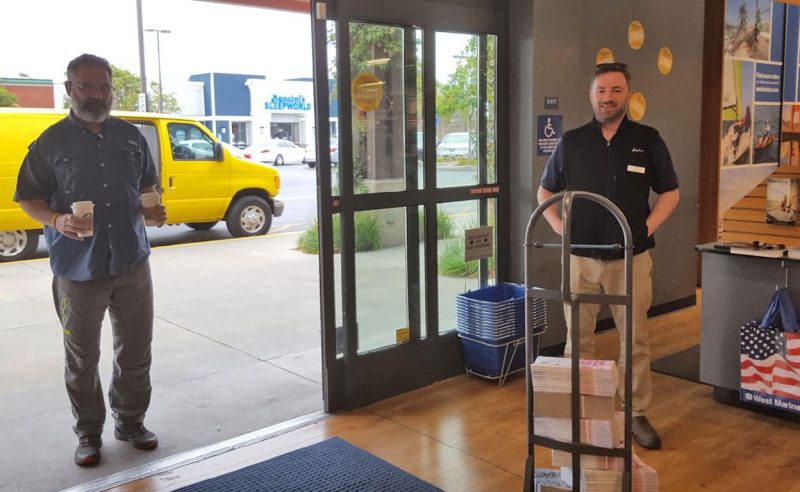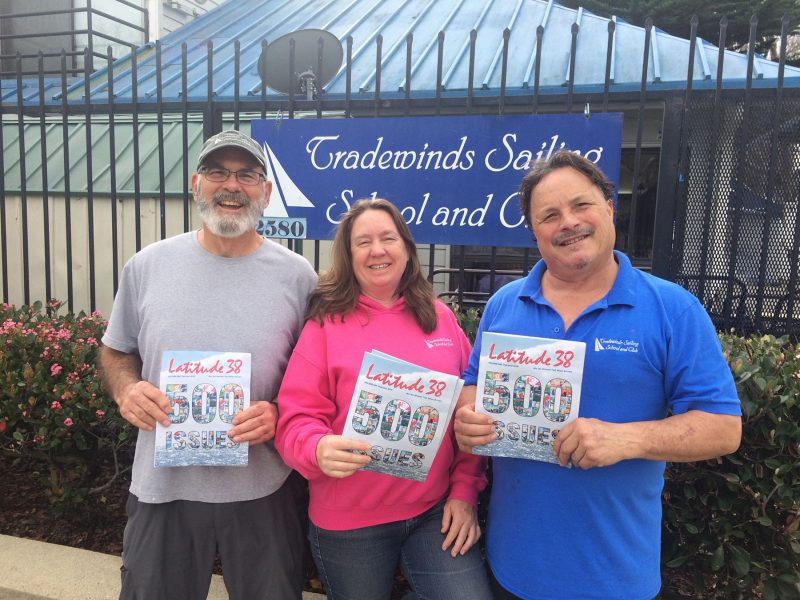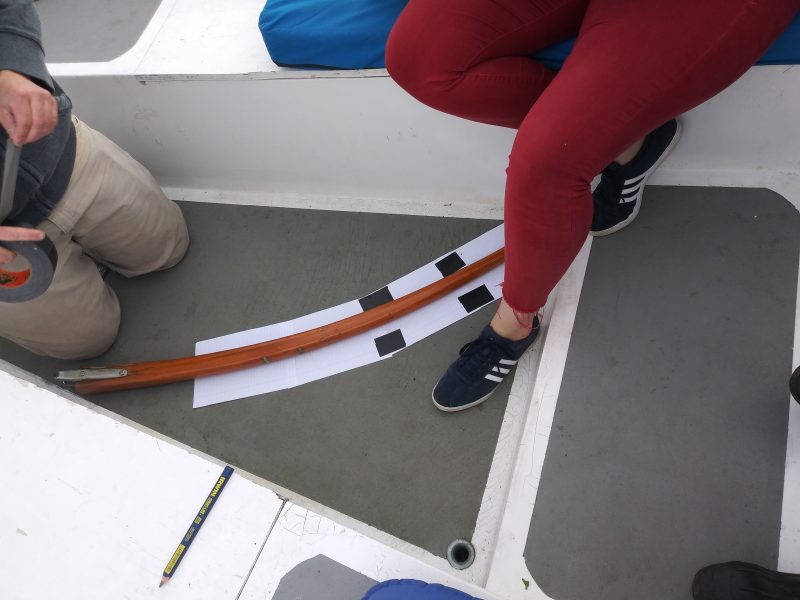
Mark Slats Finishes the Golden Globe
Dutch sailor Mark Slats, 41, took second place in the nonstop, round-the-world, solo Golden Globe Race last night aboard his Rustler 36 Ophen Maverick. Despite the late hour, Dutch, French and British supporters showed up in Les Sables-d’Olonne, France, to applaud his efforts to pass race winner Jean-Luc Van Den Heede as the two battled each other in the Atlantic Ocean. In this old-school race, an homage to (and an attempt to recreate) the first Golden Globe Race in 1968, Slats circled the globe in 214 days, 12 hours, 18 minutes and 43 seconds. But race organizers slapped him with a 36-hour penalty for improper sat phone use, which leaves him with an adjusted race time of 216 days, 00 hours, 18 minutes, 30 seconds. The boats carry satellite phones for emergency use only.

Early in the race, a tactical decision to follow the traditional clipper ship route on a wide sweep around the western side of the South Atlantic put Slats 900 miles behind VDH at the Cape of Good Hope. The Frenchman then extended his lead to 2,000 miles through the Southern Ocean, before his Matmut, another Rustler 36, pitchpoled some 1,900 miles west of Cape Horn. VDH then had to nurse a damaged mast for the rest of the circumnavigation.
Slats grasped the opportunity to catch up. By the time he rounded Cape Horn, the Dutchman had regained 500 miles. By the time they reached the Azores, the difference between them in terms of distance to finish was less than 50 miles. That’s when Slats’ luck ran out. Due to questions over the validity of his Ham radio license, Ham radio operators ostracized him. He thus missed out on regular weather updates at a critical period. “I didn’t get forecasts for seven days and ran straight into calms.”
There were also issues with Van Den Heede’s Ham license, but as he put it when talking to Slats on the dock, “I had a few French friends who kept broadcasting to me.” VDH was soon 400 miles ahead again and kept this cushion to the finish.
Slats’ most frightening moments came in the Indian Ocean. The same 60- to 70-knot storm that put paid to Ireland’s Gregor McGuckin and Indian Abhilash Tomy’s challenges slammed Ophen Maverick. “We agreed to keep in radio contact every three hours,” recalled Slats. “We spoke to each other on the first two scheds, but there was no one there for the third. I learned later from Race HQ that they had both capsized and lost their rigs.”
Two major knockdowns slapped Ophen Maverick. During the first, Slats was thrown overboard and saved only by his lifeline, which catapulted him back onto the cockpit floor. “It was a massive knockdown through 120°. Then I suffered another which filled the boat right up to the level of the nav station. That’s when I began to pray — and they were obviously answered because after pumping by hand for an hour, and with two electric pumps working, I managed to get the boat dry.”

Sir Robin Knox-Johnston, winner of the first Golden Globe Race 50 years before, sent Mark a congratulatory note: “You have my respect for a very difficult voyage well accomplished. To be second to Jean-Luc is to be at the highest level of solo sailing. A fantastic performance.”

Three skippers remain on the racecourse: Estonian Uku Randmea, American Istvan Kopar, and Finn Tapio Lehtinen. The latter is the only one still west of Cape Horn.
Latitude 38’s racing desk also received a news flash this morning from Spindrift 2’s Jules Verne Trophy attempt. Skipper Yann Guichard contacted his shore team to report damage to the starboard rudder. It is currently nighttime in the Indian Ocean, which has hampered the crew’s assessment of their situation. The maxi-trimaran is currently sailing at 15 knots some 1,200 miles off Cape Leeuwin, Australia. See www.spindrift-racing.com.
500th Issue of Latitude Out Now
Where will you pick up your copy of the 500th issue of Latitude 38? The weekend weather looks pretty awful for sailing, but just about perfect for reading about sailing in the new issue of Latitude. Yes, you can read the entire issue online but, as they say, “Ain’t nothing like the real thing baby…” Our Bay Area drivers are out there right now hoping to complete their delivery routes before the rain starts falling, making sure you have time to pick one up at your favorite Bay Area marine store before or on the weekend. Our drivers took a few minutes to send in some pics of their first deliveries from today.

Inside the new issue we have stories about Hobie Alter and the new, very cool, bronze memorial unveiled last fall in Dana Point; a profile of Taylor Canfield and the Long Beach Yacht Club America’s Cup challenge; insights from successful cruising couples; more 2018 season winners; and a look at how the Bay Area waterfront has changed over 500 issues of Latitude 38. And that’s just the beginning. There’s a challenge from Nathalie Criou’s team, Shut Up and Drive, for this year’s Race to Alaska, the Coast Guard shutdown, and most of your Letters (thank you very much to everyone who wrote in).





A good number of races are scheduled for the next couple of days, though the weather doesn’t look too cooperative. It might be a better weekend to chill out with the 500th issue of the magazine. If you do go sailing, let us know — we’re already at work on the March issue.
Thanks to all our magazine distributors who keep them on hand just for you. Give them a smile and say “Ahoy” when you stop by.
Ad: RYC Big Daddy Regatta
SailGP Coming to San Francisco
SailGP is embarking on this, its inaugural season. The tour will come to San Francisco on the weekend of May 4-5. Tickets will go on sale on Thursday, February 21, at SailGP.com.
The San Francisco engagement will be the second in a series of five events happening around the world in 2019. Sir Russell Coutts and Oracle founder Larry Ellison spearheaded SailGP, and World Sailing has sanctioned it. Each of this year’s events will feature teams representing six countries — USA, Australia, China, France, Great Britain and Japan — racing on identical 50-ft foiling catamarans, a class known as the F50. The press releases tout the F50 as “the world’s fastest, most technologically advanced flying catamaran.”

The new F50 is a redesigned incarnation of the foiling cats used for the past two America’s Cups. The F50s are expected to break the 50-knot (60 mph/100 kph) barrier.
Racing on San Francisco Bay is scheduled for noon to 2 p.m., just off the Marina, with the Golden Gate Bridge serving as the sort of stunning backdrop we Bay sailors take for granted. The teams will compete in five short-format fleet races, culminating with the top two teams facing off in a match-race finale to determine the event winner on Sunday afternoon.
“San Francisco has a unique harbor that is perfect for sailing. We are thrilled to hold our first US SailGP event in the Bay Area,” said Coutts. “The Bay’s consistently strong thermal winds will create an ideal test for these top sailors, and the shoreline serves as a natural amphitheater for spectators to take in the action. Fans in San Francisco will witness six flying catamarans going faster than ever before in a race environment — this is the next generation of sailing.”

Fans can register at SailGP.com to receive exclusive updates on unique experiences available for the event, including access to ticket pre-sales and on-water boater registration, which offers special perks for fans wishing to watch the action from personal boats. Register early to receive race management information including detailed schedules, spectator zones and the latest racecourse maps.
The five US team members are: Rome Kirby, 29, of Newport, RI (helmsman); Riley Gibbs, 22, of Long Beach (wing trimmer); Hans Henken, 26, of Coronado (flight controller); Mac Agnese, 24, of Fort Lauderdale, FL (grinder); and Dan Morris, 31, of Newport, RI (grinder).
SailGP’s 2019 season will kick off in Sydney, Australia, on February 15-16. New York will host on June 21-22; Cowes, UK, on August 10-11; and Marseille, France, on September 20-22. The September finale will feature a winner-takes-all $1 million championship match race between the season’s top two teams to conclude three days of racing.
All six SailGP teams will be in San Francisco practicing for two weeks prior to the start of the San Francisco event.
It’s the Question that Drives Us
The problem is not severe. It can barely be called a problem at all. But if you’re sitting down and helming on a long, slow run on my boat, you’ll find that you have to hunch over — almost imperceptibly — to< steer. You might even notice a little cramping creeping into your shoulders and back.
The tiller seems as if it’s just a little too low.

“So why not just, make a new tiller?” asked my friend, who is a carpenter, and was fully aware (I think) that he was volunteering for the job.
The ‘sunken-ness’ of the stick can be partially remedied by tightening up the hardware that attaches it to the rudder post. For over a year, I’ve been meaning to replace the bolts and nuts at the connection. At present, even after tightening everything with a wrench — which does put some stiffness in the tiller and helps it settle higher in the cockpit — there is an inevitable sag, and the stick eventually ends up slumping again.
But in addition to this easy and more gettable fix, I also feel like the tiller is just a hair too short, and could stand to have a little more rake in it so that it naturally curves to a higher resting position. It all sounds like a brilliant idea to me. What could possibly go wrong?

But seriously, Latitude Nation, what could go wrong? What are the disadvantages of modifying the tiller and making it larger than the original design (assuming this is, in fact, an original Columbia 24 tiller length)? I feel like tweaking the tiller is like messing with nature — not unlike those scientists who recreated dinosaurs by extracting DNA from amber.
What freakish Frankenstein might come forth? What are the unforeseen consequences?
Please either comment below or email us here, and please be sure to include your Boat Name, Make and Port of Call.

